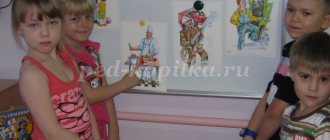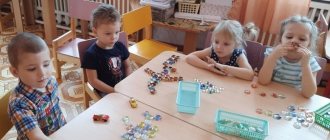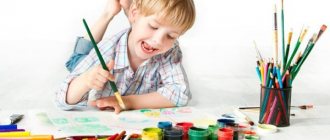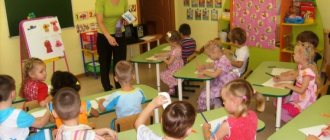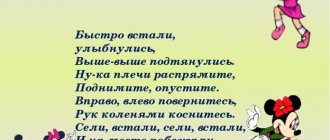The depiction of objects of different geometric shapes develops a child’s sense of volume. A balloon is a drawing for children that uses different materials - gouache or watercolor, colored and simple pencils, wax crayons.
In the process of drawing, the ability to work with these materials is consolidated. A useful skill for children is practiced - depicting the volume of objects, a sense of composition in a drawing and the correct use of color are developed.
A balloon is a drawing for children that develops a sense of volume and symmetry.
Notes on drawing “Balloons” for children of the middle group
Svetlana Panchekhina
Notes on drawing “Balloons” for children of the middle group
Topic: "Colored balls "
Program content: continue to introduce children to the techniques of depicting round and oval objects; develop hand motor skills; cultivate the desire to achieve good results.
Materials: teddy bear toy, round and oval balloons
Ioo: cognitive development; speech development.
1. Organizational moment. Educator: Guys, listen to who I’m telling you about!
The furry beast loves honey.
If he doesn't understand something,
Can roar wildly
Because he is (Bear)
“Today I invited the little bear to come visit us, but he still doesn’t come.” I wonder where he is? (a roar is heard, a bear cub appears)
. Oh, little bear, what happened?
Little Bear: I was stomping along the forest path.
I carried the balls in my hand.
He stumbled and fell - WHAM!
And my one balloon disappeared (roars)
Educator: Guys, what happened to the ball? Where did he go? (burst)
.
Oh, what a pity! How can we calm the bear cub down and cheer him up? I think I've come up with an idea, let's draw new balls for the bear! (Let's)
. Little bear, don’t be sad, the guys and I will draw new balls and not just one, but many, because we have a lot of kids.
2. Looking at a balloon . The teacher invites the children to look at the remaining balloons . Guys, what shape is the ball? (round, oval)
.
The teacher invites the children to outline this shape in the air with a movement of their hand .
3. Demonstration of drawing . The teacher shows the technique of drawing an oval with pencils , accompanying the words with the direction of movement: “Round, long, round again and long again.”
, and then invites one of the guys to show at the board how to
draw an oval-shaped balloon .
4. Independent work of children , the teacher helps individually, as needed. After finishing the work, the teacher invites the children to attach the finished drawings to the magnetic board and turns to the bear cub: “Look, little bear, what wonderful balls the guys have drawn for you .” The little bear thanks the children for the balloons and leaves.
5. Finger gymnastics at the teacher’s choice.
6. Summary: What did you do today? What did you draw ? What shape are balloons ? What color were the balloons ? For whom were the balloons drawn ?
Summary of direct educational activities in the educational field of communication in the middle group. 1. Developed in accordance with the project “Oh, these fairy tales.” 2. Topic: “Let’s call a fairy tale.” 3. Goal: To consolidate children’s knowledge about Russian folklore.
Long-term plan for design and application in the middle group for the first half of the year PERSPECTIVE PLAN FOR DESIGN AND APPLICATION SEPTEMBER. 1 (design): Topic: “Practical experimentation with paper.
Source
Hot air balloon hovering over the city
Drawing a balloon in this master class will reinforce knowledge and skills in drawing for young children. But something new will appear, namely, elements of the urban landscape. The acquisition of skills in working with color continues, and knowledge of the principles of perspective is consolidated.
To work you will need:
- drawing paper;
- a simple pencil;
- eraser;
- round and flat brushes;
- gouache;
- thin markers of different colors.
First you need to determine the center of the sheet. The entire composition will be located relative to this center. To do this, divide the sheet in half with a vertical and horizontal line.
The intersection of these lines is the center of the sheet and the composition of the drawing. Lines are drawn with a simple pencil.
The balloon will be located at the top of the sheet. At the bottom of the sheet is the city.
You need to make a sketch with a simple pencil. Mark the location of the ball in the sky. It can be placed in the center of the composition or closer to the edge of the sheet, as desired. Drawing for children doesn't have to be complicated. Therefore, the city landscape can be made a little fabulous and simple in execution.
Outline the location of the city's houses:
- The houses are depicted close to each other.
- Windows are painted on houses. They can be of different sizes - square, rectangular.
- Roofs are drawn at different heights.
- At the very bottom of the sheet you need to show the surface on which the houses are located. This is a city street. You can draw small figures of people and cars on it.
After the sketch is made, we begin to work with paints:
- Paint the background blue. This is heaven.
- Clouds are painted with white gouache.
- Color the balloon.
- They draw the roofs of the houses.
You can depict a fairy-tale city and use different colors for this. And the houses themselves can also be painted in different colors.
You can paint tiles on some house roofs. And show the brickwork on the walls. But not on all houses.
Next, you need to let the work dry. Then, with a thin felt-tip pen, you need to trace along the contour of the house, roofs, windows, tiles on the roofs. And other small details are drawn in this way. The drawing is ready.
Balloon drawing for children of any age. The master classes show the principle of creating a drawing for children of primary school age.
To make such a drawing, the child will need to master the skills of drawing three-dimensional objects, learn to work with the background, and develop spatial thinking. Drawing a round ball will help your child learn to maintain symmetry when drawing geometric shapes.
Summary of drawing lesson “Multi-colored balls”
Kots Svetlana
Summary of drawing lesson “Multi-colored balls”
Priority educational field: Artistic and aesthetic
• continue to introduce children to the techniques of depicting round and oval objects;
• develop hand motor skills;
• cultivate the desire to achieve good results
Subject-spatial development environment: a toy - a bear cub, a person in a bear costume, round and oval balloons
Planned results: They recognize a bear by its characteristic features, describe a balloon, recognize a circle and an oval, write a story about the work done.
Multicolored balloon with basket
To work you will need:
- paper;
- a simple pencil;
- ruler;
- eraser;
- paints (gouache or watercolor); colored pencils or wax crayons.
Stages of creating a drawing:
- On the sheet you need to mark the location of the ball and basket. To do this, mentally or with a light pencil line, divide the sheet into 2 parts in the center with a horizontal line. There will be a ball at the top of the sheet and a basket at the bottom.
- Drawing a ball. At the top of the sheet, mark a square with a simple pencil. A circle is drawn inside the square.
- A basket is marked at the bottom of the sheet. It is much smaller than a ball. Draw a rectangle and connect it with straight lines to the ball on the left and right. These lines are the rafters with which the basket is attached to the ball.
- At the bottom above the basket the ball narrows. Since this balloon is a drawing for children, the balloon can be compared to a lamp to make it easier to draw its shape.
- Next, you should draw 2 lines going from the very top of the ball to the basket. They need to be curved a little as they go through the round shape of the ball and cannot be straight. They seem to lie on the ball, repeating its shape.
- Add horizontal lines encircling the ball. They should also be slightly curved as they pass through a circular surface.
- The square is no longer needed, so it needs to be erased.
- They depict a burner in the basket - an air heater with which the ball flies.
- Next you need to draw the basket.
- To the already drawn vertical lines on the ball, add one more to the left and right. They also draw a line going from top to bottom in the center. It will no longer be curved, since it runs through the center of the ball and visually looks straight.
- Add another horizontal line in the center of the ball, bending it in the shape of the resulting “slices” of the ball.
- Draw basket weaving.
The sketch of the ball, drawn with a simple pencil, is ready. Now you need to paint it with bright colors using paints, wax crayons or colored pencils. To accurately draw fine details, such as the cables of a ball or the weaving of a basket, use a felt-tip pen.
Summary of GCD for drawing in the middle group “Multi-colored balls”
Zakharova Anna
Summary of GCD for drawing in the middle group “Multi-colored balls”
Age group : middle (4-5 years)
.
Topic: " Colorful balls "
Leading educational field: “Artistic creativity”
Goal: To develop children's creative potential using non-traditional visual arts techniques.
Educational: continue to introduce non-traditional drawing ( drawing with cotton swabs print -drawing technique )
, continue to develop in children the ability to carefully fill the outline of an object with color.
Strengthen ideas about the shape of an object (round, oval)
.
Enrich children's ideas about colors (green, blue.)
.
Developmental: develop imagination and color perception.
Educational: Arouse interest in drawing , cultivate friendliness by appreciating the work of other children.
Types of activities: gaming, motor, communicative, visual.
Forms of organization: group , individual.
Forms of implementation of children's activities: conversation, play, looking at illustrations, drawing .
Vocabulary: round, oval, green, blue.
Equipment: White A4 paper with an outline of balls , gouache, water jars, napkin, balls , sponge.
Preliminary work: reading and watching the fairy tale Winnie the Pooh, D/I “Pick it according to the shape”
, D/I
“Colored Rainbow”
, examination of illustrations.
Step by step process of drawing an airplane
- At the first stage, draw the outline of the airplane. Its outline is similar to a fish.
Drawing an airplane step by step
Important! Explain to children that they do not need to draw thick lines with a pencil. If necessary, inaccuracies can be removed with an eraser.
- The wings are being drawn. This is an important element. The wing, which is located behind the body, needs to be drawn partially. The wings are shaped like triangles with rounded corners;
- Draw small wings on the back of the tail. Draw a rectangular front window on the front of the hull, and round portholes throughout the hull.
Drawing an airplane flying through the clouds can take a lot of time, as it requires drawing a large number of details, smooth geometric shapes and lines. Nevertheless, most boys will be delighted with this activity. Girls will also love the beautiful airplane drawn with their own hands. And the teacher’s correct approach to organizing the lesson will help to depict an airplane easily and quickly.
MAGAZINE Preschooler.RF
Technology of research activity Journey along the “river of time” The abstract was developed by Svetlana Vladimirovna Ershova, teacher of preschool educational institution No. 18, Nevsky district, St. Petersburg 2014 “Travel in a hot air balloon” (“Cognition” formation of a holistic picture of the world, games with TRIZ elements)Goal: expand the cognitive interests of children; introduce air vehicles in the distant past. Educational objectives: - To introduce the means of transportation of ancient people over long distances; — Enrich children’s social knowledge and vocabulary.
Developmental: - Develop auditory perception and attention; — Teach children to create new images in their imagination based on the perception of schematic images; — Develop logical thinking; — Learn to transform objects, coordinating them according to the principle of unification and universality. Educational: - Cultivate interest in the actions and objects of the surrounding world. Health-saving: — Prevention of visual impairment; — Prevention of postural disorders. Integration of educational areas: “Socialization”, “Cognition” - FEMP, “Communication”, “Safety”, “Health”.
Materials: a balloon (a toy - an inflatable ball) with a basket (a small round wicker basket) and a load (small transparent bags with sand, small pebbles); illustrations and images of air transport; subject pictures of the teacher's choice; 3-4 toys - animals; geometric figure - a square divided into 3 parts; geometric figure - a circle for each child; counting sticks; drawings - diagrams; contour diagram of clouds; musical accompaniment; various waste materials (ribbons, boxes...). Progress of educational activities 1. Introducing the balloon. Children sit in a semicircle. The teacher shows images of air transport, children look at the pictures and name the transport. Next, the teacher shows in the picture (illustration from the book) an image of a balloon. Teacher. What do you think it is? Listen to the children's answers. Teacher. Once upon a time, there was no transport on our planet. People walked. While admiring the flights of birds, man has always dreamed of flying. At first, people invented wings, but they could not fly into the sky. Time passed, the interest in flying into the sky remained, and the man came up with a hot air balloon. People began to travel in hot air balloons. Music sounds and a balloon (toy) with animal passengers appears in the group. The teacher, together with the children, discusses the “flight” of animals using leading questions: - Where are the animals going to fly, on what? (answer options). — What is the balloon made of? — Why does a hot air balloon fly? (presence of air). - Why can’t animals take off in a hot air balloon? (the load gets in the way). — What can and should you take with you on a trip? (subject pictures). — Is everything prepared for the animals for a safe flight? (checking the technical condition of the balloon, necessary items, water). After a joint discussion, the animals take flight. (A hook is attached to the ceiling; a thick fishing line is threaded through it, with the help of which the “balloon” can rise to the required height. The fishing line can be fixed in any convenient place in the room.) Teacher. Guys, what do they usually say when they send friends on a trip? Children. Have a safe flight, we will miss you, take care of yourself, come back - we are waiting for you, interesting events, fair winds... 2. Working with riddles (optional). The teacher invites the children to guess the riddle: - What kind of ceiling is this? He is neither low nor high. Sometimes he is gray, sometimes he is whitish. It's a little bluish. And sometimes so beautiful. Lace and blue-blue? Children. Sky. 3. Game exercise “What do clouds look like?” Teacher. Look at the beautiful clouds our friends are flying past in a hot air balloon. Look carefully and tell me what the clouds look like? The teacher places a contour diagram of clouds on the board (different diagram options are possible). The music is playing - the song “White-Maned Horses”. Children. On a boot, a bird, a mouse, a flower, an airplane, a car, a cat, a bear’s face... 4. Game exercise “Sun in the clouds” (prevention of visual impairment). Teacher. How warm we feel from the sun. Let's draw it with our eyes. Fix your chin, do not turn your head. 5. Game task “What do animals see from a balloon?” Teacher. What do you think can be seen from a hot air balloon below? Children. Land, forest, houses, road... The teacher invites the children to look at the drawings and diagrams and, according to verbal instructions, find the desired image. Teacher. Find a picture of children playing in the area? You can complicate the task and invite the children to use a drawing diagram to tell what can be seen from a hot air balloon. Teacher. What can you see from a hot air balloon now? 6. Dynamic pause “Sun” (prevention of postural disorders). Teacher. Get comfortable, let's play with the sun while the animals travel. This is how the sun rises - higher, higher, higher. (Raise your arms up, stretch.) By night the sun will set - lower, lower, lower. (Squat down. Put your hands down.) Well, well, the sun laughs well, And we all live happily under the sun. (Clap your hands, smile.) 7. Game task “Balloon”. The children sit at the tables. Teacher. You probably really want to build a hot air balloon yourself? Children. Yes, we really want to! Teacher. To do this, we must first build a basket, prepare a ball and firmly attach the basket to the ball so that our structure is reliable and safe. A diagram is placed on the board - a sample of future construction. Children are given geometric shapes - squares of different colors, divided into 3-4 parts. Teacher. Select pieces of the same color and fold them to form a square. This will be a basket for passengers. Children assemble a basket - a square of parts. Then the teacher gives the children “balls” (plane image - circles) and asks them to use counting sticks to attach a basket to the ball. Teacher. Well done! Now we need to securely attach the basket to the balloon. Children complete the task. 8. Task “Strange objects”. Teacher. Look what these items are. Children. Ribbons, boxes, jars, colorful ropes, balloons, balls. Teacher. Look carefully at these items and tell me why they can be useful to us? Children. To build a balloon for games. Teacher. You have learned how to build “Balloons” and today a surprise awaits you. Look, the animals are returning, let's welcome them. Animals. It was very interesting for us to travel. And you built such beautiful, reliable balloons, we saw them from above. Well done! But it's time for us to move on. Our families are waiting for us and worrying about us. Goodbye! Children. Goodbye, come visit us again! 9. Summary of the lesson. The teacher finds out whether the children were interested and what they liked most. After listening to the children’s answers, the teacher summarizes. -A lot of time passed and people created a steam locomotive, an airplane, and then rockets and spaceships. The teacher gives the children “Balloons” made from balloons, satin ribbons and various boxes and invites them to play with them on the street.
| Next > |

